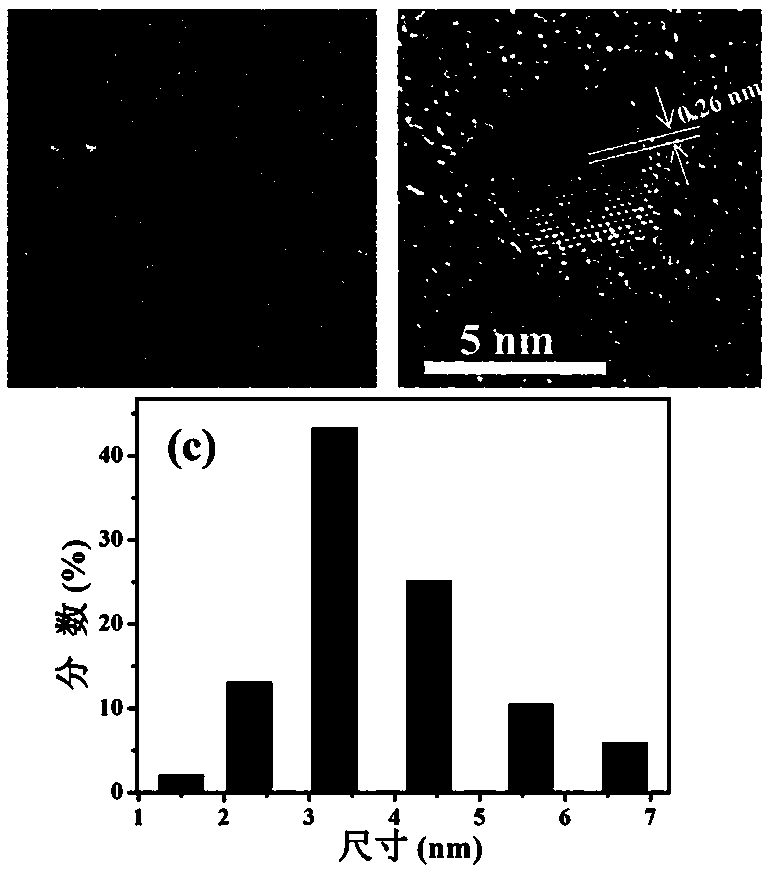Preparation method and application of boron and nitrogen co-doped carbon dot
A technology of co-doping and carbon dots, applied in measuring devices, instruments, fluorescence/phosphorescence, etc., can solve problems such as complex processes and expensive costs, achieve low cost and improve the quantum yield of carbon dots
- Summary
- Abstract
- Description
- Claims
- Application Information
AI Technical Summary
Problems solved by technology
Method used
Image
Examples
preparation example Construction
[0024] A typical embodiment of the present invention provides a method for preparing boron-nitrogen-doped carbon dots, comprising the steps of: placing diammonium hydrogen citrate and pinacolate diboron in a lined polytetrafluoroethylene reactor, and then adding Ultrapure water was heated at 160-240°C for 6-12 hours. After the reaction stopped, the solution was naturally cooled to room temperature, and the solution was centrifuged at high speed, filtered and freeze-dried. The obtained yellow solid powder was the fluorescent carbon dot.
[0025] In the above embodiments, diammonium hydrogen citrate and pinacol diboron are used as carbon and boron sources, the raw materials are non-toxic, cheap and easy to obtain, and the reaction conditions are mild, and can be prepared in a general laboratory. It was found in the experiment that the quantum yield of carbon dots prepared only with diammonium hydrogen citrate as the carbon source was not high, and the addition of pinacol and dibo...
Embodiment 1
[0036] Preparation of boron-nitrogen-doped carbon dots: Weigh 0.4g of diammonium hydrogen citrate and 0.8g of pinacolate diboron into a polytetrafluoroethylene-lined reactor, then add 20mL of ultrapure water, React at 200°C for 8h. After the reaction was completed, cool to room temperature to obtain a solution of boron-nitrogen-doped carbon dots. The solution was centrifuged at a high speed of 8500 rpm / min for 10 min, then filtered with a 0.22 µm filter membrane, and then freeze-dried to obtain a yellow solid. The solid Disperse in ultrapure water for easy characterization, and store at around 4°C until use. For its properties, see Figure 1-5 .
Embodiment 2
[0038] Preparation of boron-nitrogen-doped carbon dots: Weigh 0.6g of diammonium hydrogen citrate and 0.6g of pinacolate diboron into a polytetrafluoroethylene-lined reactor, then add 20mL of ultrapure water, React at 200°C for 8h. After the reaction was completed, cool to room temperature to obtain a solution of boron and nitrogen doped carbon dots. The solution was centrifuged at a high speed of 8500 rpm / min for 10 min, then filtered with a 0.22 µm filter membrane, and then freeze-dried to obtain a yellow solid. Disperse into ultrapure water for easy characterization, and store at around 4°C until use.
PUM
 Login to View More
Login to View More Abstract
Description
Claims
Application Information
 Login to View More
Login to View More - R&D
- Intellectual Property
- Life Sciences
- Materials
- Tech Scout
- Unparalleled Data Quality
- Higher Quality Content
- 60% Fewer Hallucinations
Browse by: Latest US Patents, China's latest patents, Technical Efficacy Thesaurus, Application Domain, Technology Topic, Popular Technical Reports.
© 2025 PatSnap. All rights reserved.Legal|Privacy policy|Modern Slavery Act Transparency Statement|Sitemap|About US| Contact US: help@patsnap.com



